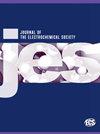Electrochemical Investigation of Moisture Byproducts in Molten Calcium Chloride
IF 3.3
4区 工程技术
Q2 ELECTROCHEMISTRY
引用次数: 0
Abstract
Residual water in molten CaCl2 reacts to form different byproducts, such as HCl, which can impact the corrosivity of the salt and efficiency of electrochemical operations, such as electrolytic oxide reduction and electrorefining. The ability to detect and quantify these byproducts electrochemically can provide feedback on the efficacy of vacuum drying and other purification methods, as well as the impact of these byproducts on process operations. An electrochemical signal’s association with the production of H2 is verified and characterized using cyclic voltammetry (CV) and residual gas analysis. CV estimated a 2-electron exchange process associated with H2 production. CV detected trace quantities of an oxidized species containing hydrogen in the salt on the order of 10 ppm. Different salt handling methods were compared for their impact on the hydrogen electrochemical signal. It was found that 30 min of exposure of CaCl2 in a beaker to low-humidity air (<20%) had minimal impact on the H2 production signal.熔融氯化钙中水分副产物的电化学研究
熔融 CaCl2 中的残留水会发生反应,形成不同的副产品,如 HCl,从而影响盐的腐蚀性和电化学操作(如电解氧化还原和电精炼)的效率。通过电化学方法检测和量化这些副产物,可以反馈真空干燥和其他提纯方法的效果,以及这些副产物对工艺操作的影响。使用循环伏安法(CV)和残余气体分析法对电化学信号与 H2 生成的关系进行了验证和表征。CV 估算了与 H2 生产相关的双电子交换过程。CV 检测到盐中含有氢的氧化物的痕量数量约为 10 ppm。比较了不同的盐处理方法对氢电化学信号的影响。结果发现,将烧杯中的 CaCl2 暴露于低湿度空气(<20%)中 30 分钟,对 H2 生成信号的影响微乎其微。
本文章由计算机程序翻译,如有差异,请以英文原文为准。
求助全文
约1分钟内获得全文
求助全文
来源期刊
CiteScore
7.20
自引率
12.80%
发文量
1369
审稿时长
1.5 months
期刊介绍:
The Journal of The Electrochemical Society (JES) is the leader in the field of solid-state and electrochemical science and technology. This peer-reviewed journal publishes an average of 450 pages of 70 articles each month. Articles are posted online, with a monthly paper edition following electronic publication. The ECS membership benefits package includes access to the electronic edition of this journal.

 求助内容:
求助内容: 应助结果提醒方式:
应助结果提醒方式:


